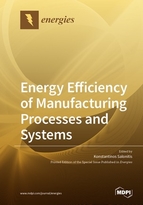Energy Efficiency of Manufacturing Processes and Systems
A special issue of Energies (ISSN 1996-1073). This special issue belongs to the section "F: Electrical Engineering".
Deadline for manuscript submissions: closed (1 January 2020) | Viewed by 49845
Special Issue Editor
Interests: sustainable manufacturing systems; green manufacturing; environmental impact assessment; simulation; modelling
Special Issues, Collections and Topics in MDPI journals
Special Issue Information
Dear Colleagues,
The availability and affordability of energy affect the whole life cycle of a product and subsequently the production phase as well. Manufacturing activities are responsible for one third of the global total energy consumption and CO2 emissions. Thus producing with higher energy efficiency has been the focus of research in recent years and is nowadays considered one of the key decision-making attributes for manufacturing. This Special Issue considers the energy efficiency of both manufacturing processes and systems. Papers are particularly invited in the following areas:
- Methods for the measurement of energy efficiency, including obtaining performance data from older production technologies
- Tools and techniques for the analysis and development of improvements with regards to energy consumption
- Tools and techniques for the modelling and simulation of energy efficiency for both manufacturing processes and systems
- Continuous improvement methodologies and cases
- Case studies on the management of such systems and what practices are necessary to maintain
- Green and lean manufacturing
Prof. Dr. Konstantinos Salonitis
Guest Editor
Manuscript Submission Information
Manuscripts should be submitted online at www.mdpi.com by registering and logging in to this website. Once you are registered, click here to go to the submission form. Manuscripts can be submitted until the deadline. All submissions that pass pre-check are peer-reviewed. Accepted papers will be published continuously in the journal (as soon as accepted) and will be listed together on the special issue website. Research articles, review articles as well as short communications are invited. For planned papers, a title and short abstract (about 100 words) can be sent to the Editorial Office for announcement on this website.
Submitted manuscripts should not have been published previously, nor be under consideration for publication elsewhere (except conference proceedings papers). All manuscripts are thoroughly refereed through a single-blind peer-review process. A guide for authors and other relevant information for submission of manuscripts is available on the Instructions for Authors page. Energies is an international peer-reviewed open access semimonthly journal published by MDPI.
Please visit the Instructions for Authors page before submitting a manuscript. The Article Processing Charge (APC) for publication in this open access journal is 2600 CHF (Swiss Francs). Submitted papers should be well formatted and use good English. Authors may use MDPI's English editing service prior to publication or during author revisions.






